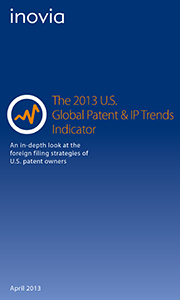 Patent services provider inovia announced the release of its 2013 report on global patent and IP trends today. In compiling the report, inovia, which produces products for PCT national phase entry, European patent validation, and patent translations, surveyed 125 U.S. companies and universities in January 2013 to identify the trends having the greatest impact on the foreign filing strategies of U.S. patentees.
Patent services provider inovia announced the release of its 2013 report on global patent and IP trends today. In compiling the report, inovia, which produces products for PCT national phase entry, European patent validation, and patent translations, surveyed 125 U.S. companies and universities in January 2013 to identify the trends having the greatest impact on the foreign filing strategies of U.S. patentees.
The 2013 report notes that 23% of survey respondents are involved in the pharmaceuticals, biotech, or medical devices industries. Other sectors or groups represented in the survey include chemicals/materials (13%), electrical/electronics (10%), mechanical/engineering (10%), IT/software/media (7%), and university/association/non-profit (18%). The report also indicates that one-third of survey respondents (33%) had no in-house patent attorneys or agents, 47% had one to four in-house patent attorneys or agents, and the remainder (20%) had five or more attorneys or agents. With respect to the number of in-house patent attorneys or agents, the trend was towards increasing numbers of in-house practitioners (the 2012 report indicated that 37% of survey respondents had no in-house patent attorneys or agents, 46% had one to four in-house patent attorneys or agents, and 17% had five or more attorneys or agents).
The report states that among survey respondents, "[t]he theme of 'cautious optimism' from previous surveys continues." The report notes, however, that "respondents don't foresee too much growth in terms of the number of patent families expected to be filed in 2013." Fewer respondents experienced IP budget cuts in 2012 than in 2011, and a greater percentage brought in in-house support or outsourced annuity payments. Half of respondents cited final implementation of the Leahy-Smith America Invents Act as the most important issue/trend of 2013. Other key trends for 2013 included cost containment, the rising cost to obtain patent protection, as well as enforcement and patent trolls.
With respect to application filings, 11% of survey respondents said they filed more patent applications in 2012 than they expected (down from 18% in 2011), 16% said they filed fewer patent applications (up from 15% in 2011), and 73% said they filed as many patent applications in 2012 as they expected (up from 67% in 2011). The results of this year's survey, however, were a significant improvement over those from inovia's first survey (released in 2010), where 41% of respondents said they filed fewer applications than expected in 2009.
The 2013 report indicates continued growth for international patent protection, as 50% of respondents filed more than half of their patent applications abroad (up from 42% in last year's report). Respondents, however, are even more selective with their filings abroad, with 22% of respondents filing corresponding applications in only 1-3 foreign countries and another 32% filed internationally in 4-19 countries (the 2012 report indicated that 37% of respondents filed corresponding applications in 1-3 foreign countries and another 42% filed internationally in 4-8 countries; this year's survey did not provide a breakdown of the percentage of respondents filing in 4-8 countries).
With regard to the countries in which respondents regularly filed, 23% added new countries to their list (up from 21% in 2011 and 17% in 2010), with 14% adding China and smaller percentages adding South American countries, India, South Africa, South Korea, and Japan. Noting that 28% of respondents added China to their list in 2011, the report stated that the drop could be an indication that China is now a regular filing destination for many U.S. applicants. A smaller percentage of respondents (19%) dropped countries from their lists (up from 17% in 2011), with the European Patent Office or individual European countries being dropped by 24% of respondents who pared down their lists, 10% dropping China, Japan, and Mexico, and 7% dropping Australia, Canada, South Korea, and Russia from their lists. Respondents who dropped the European Patent Office or individual European countries believed that the high cost of pursuing such protection did not justify the value. In ranking foreign jurisdictions, respondents placed Europe, China, and Japan first, second, and third, respectively, which was the same ranking respondents provided in last year's report.
Finally, the report noted that a large majority of respondents (99%) rely on the PCT for foreign filing. Of these respondents, 75% selected the EPO as an International Searching Authority (up from 72% in 2011), 50% selected the Korean IP Office (KIPO) (up from 42% in 2011), and 11% selected the Japan Patent Office (JPO) (down from 12% in 2011).